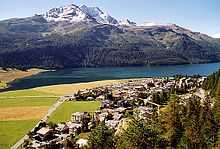Lake Silvaplana
| Lake Silvaplana Silvaplanersee Lej da Silvaplauna | |
|---|---|
 View from the south-western shore towards Silvaplana | |
| Location | Engadin, Grisons |
| Coordinates | 46°26′56″N 9°47′33″E / 46.44889°N 9.79250°ECoordinates: 46°26′56″N 9°47′33″E / 46.44889°N 9.79250°E |
| Primary inflows | Inn (named Sela after Lake Sils), Fexbach, Ova dal Valhun |
| Primary outflows | Lake Champfer (Inn) |
| Catchment area | 129 km² |
| Basin countries | Switzerland |
| Max. length | 3.1 km |
| Max. width | 1.4 km |
| Surface area | 2.7 km² |
| Average depth | 48 m |
| Max. depth | 77 m |
| Water volume | 0.14 km³ |
| Residence time | c. 250 days |
| Surface elevation | 1790.54 m |
| Settlements | Sils Maria, Silvaplana |
Lake Silvaplana (German: Silvaplanersee; Romansh: Lej da Silvaplauna) is a lake in the Upper-Engadine valley of Grisons, Switzerland. It takes its name from the village of Silvaplana. The lake is also connected to the nearby Lej da Champfèr. Together with its larger neighbour, Lake Sils, it is among the largest lakes of the Grisons.

A campsite is located on the Northern end of the lake. The lake is also used heavily for sports, such as kitesurfing and windsurfing in the summertime. In the winter, once the lake freezes, it is used for cross country skiing, walking trails, and kitesurfing on snow, with the famous Engadin Skimarathon crossing the lake annually. The rare occasion of black ice also brings ice skaters to the lake.
In Ecce Homo, Friedrich Nietzsche recounts the moment he first conceived his idea of the Eternal Recurrence while walking through the woods beside Lake Silvaplana in August 1881.
External links
![]() Media related to Lake Silvaplana at Wikimedia Commons
Media related to Lake Silvaplana at Wikimedia Commons
- Lakes of the Upper Engadine valley in Romansh, German, French and Italian in the online Historical Dictionary of Switzerland.